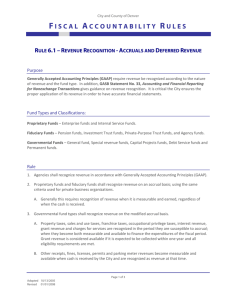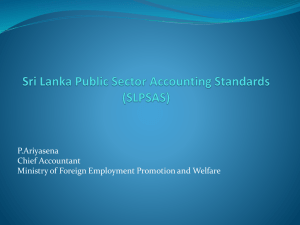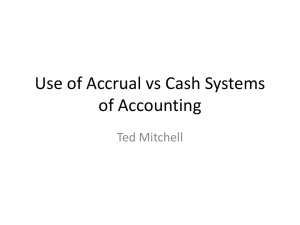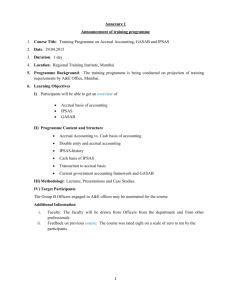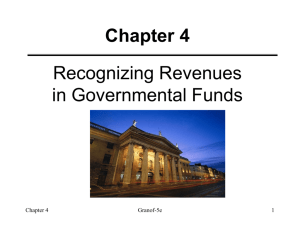GASB 34 compliance from NYS Office of the Comptroller
advertisement
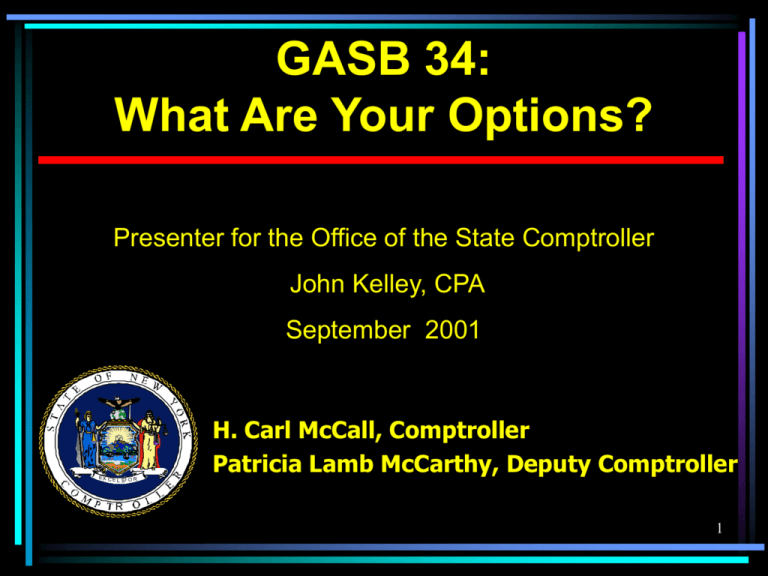
GASB 34: What Are Your Options? Presenter for the Office of the State Comptroller John Kelley, CPA September 2001 EX C E L SI O R H. Carl McCall, Comptroller Patricia Lamb McCarthy, Deputy Comptroller R 1 GASB 34’s Goal To answer key questions: Did financial position improve or deteriorate? Were this year’s revenues sufficient to pay for services? What’ s the overall cost of services? How were programs financed-revenues, fees, grants? How much is invested in capital assets? 2 GASB 34’s Major Changes A second set of financial statements (Government-wide statements) using different accounting rules, including reporting depreciation and infrastructure. A letter (Management’s Discussion and Analysis) explaining what happened. 3 GASB 34 Implementation Phases Phase Implement Retroactive GASB 34 in Infrastructure by Years Beginning After June 15 1 2001 2005 2 2002 2006 3 2003 Optional 4 GASB 34 Revenue Calculation Total revenues (980 account) for all funds $_______ (except internal service)* Minus: Interfund transfer revenues) (______) (account 5031 Minus: Other financing sources (______) (borrowings, sale of land, etc.) 5 GASB 34 Revenue Calculation (Continued) Minus: Extraordinary items (______) (GASB 34, paragraph 53) (Disaster Aid, etc.) Total revenues for first year ending after $_______ 6/15/99 If Over $100 Million = Phase 1 If $10 – 100 Million = Phase 2 If Under $10 Million = Phase 3 6 Implementation Phases In NYS 1 2 25 31 1 57 5 46 10 61 Schools 19 467 220 706 Towns 7 58 867 932 Villages 0 20 533 553 Fire Districts 0 0 858 858 56 622 2,489 3,167 2% 20% 78% 100% Counties Cities Total 3 Total 7 If FY ends June 30- Nov. 30 Phase First Year Affected is Add Retroactive Infrastructure by 1 2001-02 2005-06 2 2002-03 2006-07 3 2003-04 Optional 8 If FY ends December 31 Phase First Year Affected is Add Retroactive Infrastructure by 1 2002 2006 2 2003 2007 3 2004 Optional 9 If FY ends Jan. 31 -May 31 Phase First Year Affected is Add Retroactive Infrastructure by 1 2002-03 2006-07 2 2003-04 2007-08 3 2004-05 Optional 10 GASB 34 Core Financial Reporting 1. 2. 3. 4. Government-wide Financial Statements Fund Financial Statements Notes to Financial Statements Required Supplemental Information • Management’s Discussion and Analysis (MD&A) • Budgetary Comparison Statement • Infrastructure Data (only if modified approach is used – no depreciation) 11 What is OSC policy ? OSC collects only fund level information in the legally required annual financial report. OSC encourages local governments to implement GAAP (generally accepted accounting principles), while recognizing that full implementation may not always be cost beneficial. Local governments need to do a cost benefit analysis. This involves the governing board, chief fiscal officer, and other officials. 12 Financial Reporting Issues Full implementation of GASB 34 is needed to meet GAAP reporting and to get a “clean” (unqualified) opinion on audited financial statements. May affect bond rating. Federal Single Audit Act is triggered when governments expend more than $300,000 of federal money. 13 What It Means To You A cost benefit analysis involves the governing board, chief fiscal officer and department heads. Can you do it with existing staff? What outside help do you need? What records do you have? 14 Capital Assets Must Be Reported Land, buildings and equipment. Infrastructure (roads and bridges and sewer and water lines, etc.) Capitalization thresholds need to be set. What are repairs versus improvements? 15 Capitalization Thresholds Used by NYS for Equipment 1980’s 15,000* 1990’s 25,000 2000’s ? *cars under $15,000 weren’t reported 16 Capitalization Thresholds GAAP thresholds can be different for: Different types of assets Existing assets Newly acquired assets 17 Capitalization Thresholds Are different for: Inventory Control Insurance Legal Requirements (e.g. Federal Common Rule $5,000) Financial Reporting (GAAP) 18 Buildings and Equipment Must Be Depreciated Historical Cost – can be estimated Salvage Value- could be zero Useful Life- period of probable usefulness (Local finance Law 11.00 Age of Asset – can be estimated Depreciation Method –straight-line 19 Infrastructure – “Depreciation Expense” Options Report depreciation expense in the government-wide statements. (Note: Depreciation isn’t budgeted or reported in the fund financial statements; i.e.; the general fund and other governmental funds.) 20 Infrastructure – “Depreciation Expense” Options (continued) OR Use the “Modified Approach” (If an Asset Management System is in place that meets certain rules, the money spent to maintain assets serves as a surrogate for depreciation expense.) 21 Retroactive (Existing) Infrastructure Options Phase 3 units can elect to not report it at all. (Report it, if there’s outstanding debt.) Phase 1 and 2 governments: - Can delay reporting up to 4 years. - Can go back to June 30, 1980 only. - Can limit to “major general” infrastructure. 22 Retroactive (Existing) Infrastructure Options (Continued) Can calculate initial capitalization, using deflated current replacement cost to represent estimated historical cost. Can use bond documents, engineering documents, and capital projects funds expenditures as source documents when estimating historical cost. 23 Retroactive (Existing) Infrastructure Options (Continued) Can use composite depreciation rates based on groupings of similar assets or classes of dissimilar assets. 24 Identifying Undepreciated Capital Assets What outstanding debt do you have for capital assets? Are depreciation expense and principal payments about equal? Are useful life and period of probable usefulness about equal? ($ Borrowed – principal payments = Outstanding Debt) (Asset cost – accumulated depreciation = Book Value) 25 Land, Buildings and Equipment Set high capitalization thresholds Use assessment rolls for land and buildings Equipment (vehicles, machinery, equip.) Capitalize large equipment to get started (highway vehicles, buses, fire engines, etc.) Use lower threshold after 34 implementation (GAAFR “no lower than $5,000”) 26 Identifying Undepreciated Infrastructure What infrastructure was acquired since June 30, 1980? Acquired, significantly reconstructed, or received significant improvement. Look at outstanding debt. Look for items that aren’t bonded (CHIPS capital projects) 27 Identifying Undepreciated Infrastructure Look back 10 years to identify CHIPs projects that aren’t fully depreciated. • Do they have a 10-year useful life? • Are they repairs or improvements? • Are they above your capitalization threshold? Look back beyond 10 years for significant projects only. 28 Interpretation No. 6 “Recognition and Measurement of Certain Liabilities and Expenditures in Governmental Fund Financial Statements.” Effective date coincides with implementation of Statement No. 34. 29 Modified Accrual Basis – Flow of Current Financial Resources NCGA 4 - Recognize long-term liabilities to the extent that they are "normally expected to be liquidated with expendable available financial resources.” GASB Int. 6 - Recognize these liabilities to the extent they mature (come due for payment) each period. 30 Current vs. Long-Term Matured portions of the above liabilities should be reported as governmental fund liabilities Long-term liabilities in GLTDAG Accumulated money is reported as reserved fund balance 31 Reserve for Employee Benefit Accrued Liability General Municipal Law 6-p. The purpose of this account is to reserve funds for the payment of any accrued employee benefit due to an employee upon termination of service. This reserve fund may be established by a majority vote of the board and is funded by budgetary appropriations and such other reserves and funds that may be legally appropriated. 32 Statement No. 33 Accounting and Financial Reporting for Nonexchange Transactions Nonexchange transaction – a government gives (or receives) value without directly receiving (or giving) equal value in return (e.g., property taxes) 33 Statement No. 33 Exchange transaction each party receives and gives up essentially equal values (e.g., sale of merchandise) The issue is the timing of recognition of nonexchange transactions 34 Statement No. 33 - Classes of Nonexchange Transactions Derived tax revenues (e.g., income taxes, sales tax) Imposed nonexchange revenues (e.g., property taxes, fines) Government-mandated nonexchange revenues (e.g., Federal & State mandated programs) Voluntary nonexchange transactions (e.g., certain grants and private donations) 35 Statement No. 33 Revenue Recognition Derived tax revenues – when underlying exchange transaction has occurred (e.g., income was earned, sale was made) Imposed nonexchange revenue – when use of resources is permitted (e.g., period for which property taxes are levied) 36 Statement No. 33 – Revenue Recognition Government-mandated revenues and voluntary nonexchange transactions – when applicable eligibility requirements are met (e.g., for certain grants when expenditure is incurred) 37 Statement No. 33 – Revenue Recognition Availability criterion – must be met for all non-exchange transactions Receivables for Federal and State grants Effective date – FYE June 30, 2001 38 Implementation Process For governmental funds, fund financial statements (modified accrual basis) will continue to be prepared as they are today 39 Implementation Process To prepare government-wide statements, combine funds and account groups and convert modified accrual to accrual 40 Implementation Process 41 Trial balance with adjusting entries Conversion to accrual will be in subsidiary records or workpapers only 42 Implementation Process Books for subsequent year will be opened with modified accrual balances from prior year 43 To Convert From Modified Accrual to Full Accrual Report revenue that is not yet available. Report expense for supplies inventories and prepaid items (insurance) based on usage (rather than when outlays are made). Report supplies inventories and prepaid items (insurance) as assets in statement of net assets. 44 To Convert From Modified Accrual to Full Accrual Remove proceeds of long-term debt from operating statement, and report liability in statement of net assets. Report interest expense when incurred (rather than when paid). Report accrued liability in statement of net assets. 45 To Convert From Modified Accrual to Full Accrual Remove debt service principal and interest outlays from operating statement, and reduce liabilities for debt (principal) and accrued interest payable in statement of net assets. 46 To Convert From Modified Accrual to Full Accrual Remove outlays from operating statement and replace with expense for certain operating liabilities (compensated absences, claims and judgements, landfill closure and post closure costs, special termination benefits). Report liability in statement of net assets. 47 To Convert From Modified Accrual to Full Accrual Remove capital outlays from operating statement. Report as capital assets in statement of net assets. Report depreciation expense in statement of activities and accumulated depreciation in statement of net assets. 48 To Convert From Modified Accrual to Full Accrual Remove sale of assets (revenue) from operating statement and replace with gain/loss on sale of assets in statement of activities. Remove asset and accumulated depreciation from statement of net assets. 49 Internet Resources gasb.org Governmental Accounting Standards Board nasact.org National Association of State Auditors, Comptrollers and Treasurers gfoa.org Government Finance Officers Association osc.state.ny.us NYS Comptroller’s Office 50 GASB Lite Use a least cost implementation strategy There are many options in implementing GASB 34. If it doesn’t make a big difference, don’t do it. 51 OSC Plan To provide guidance on implementation issues. Change NYUSA to facilitate GASB 34 Reporting Questions? Contact OSC Regional Offices. 52
